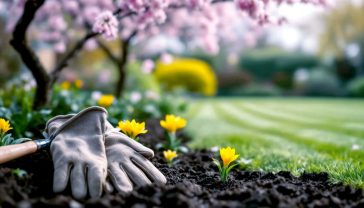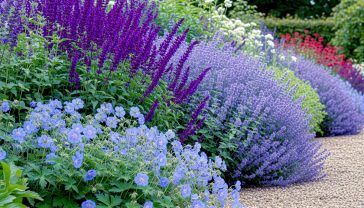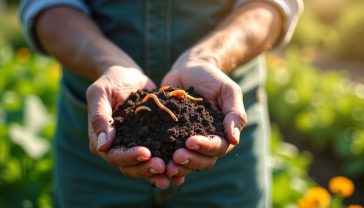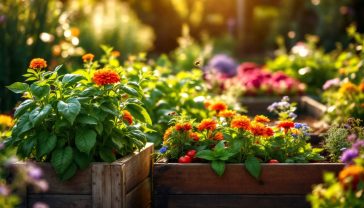The Great British Sow-Along: What to Plant in Every Season
The UK seasonal sowing guide. Learn what vegetables, flowers, and herbs to plant in spring, summer, autumn, and winter for a thriving garden all year.
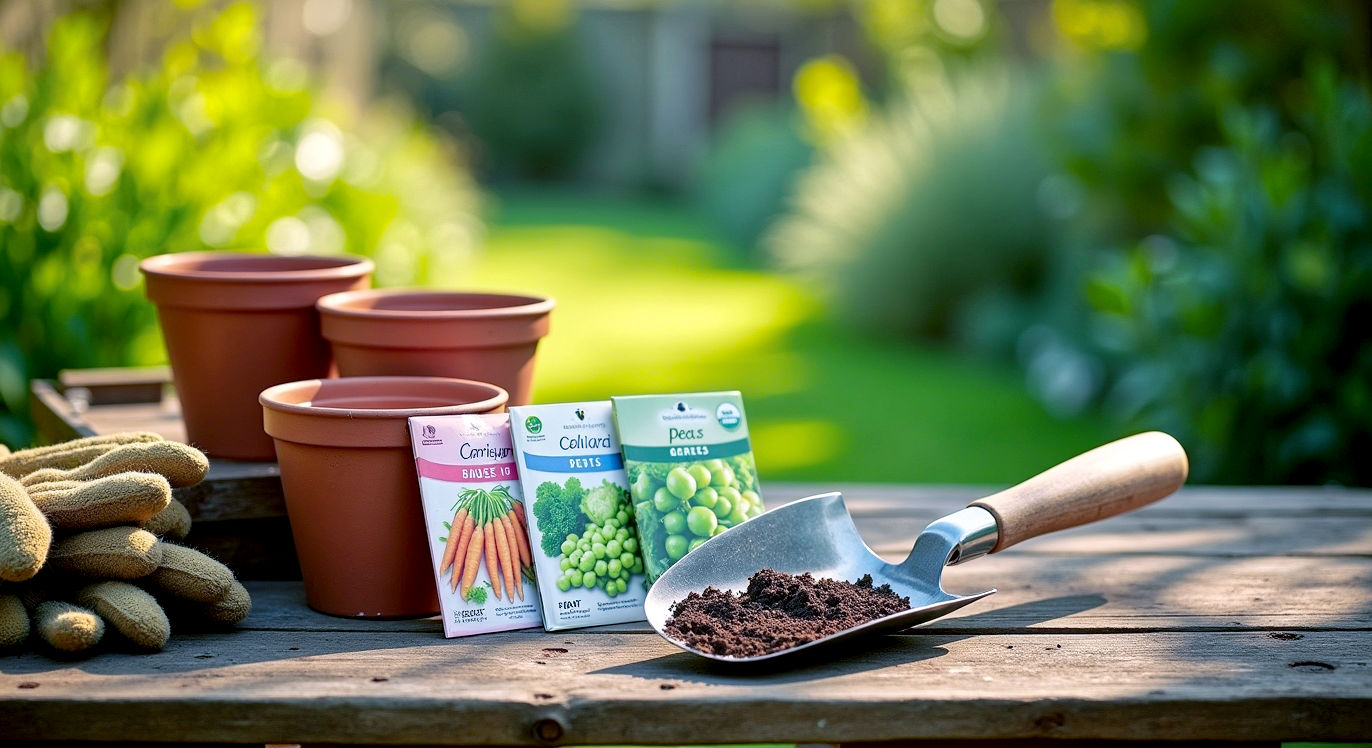
This post may contain affiliate links. If you make a purchase through these links, we may earn a commission at no additional cost to you.
There’s a special kind of magic in gardening. It’s the quiet thrill of pushing a tiny, unassuming seed into the dark soil and waiting. It’s the jolt of excitement when the first bright green shoots poke their heads into the world. And it’s the deep, honest satisfaction of sitting down to a meal you’ve grown yourself. Here in Britain, we’re a nation of gardeners, but our famously fickle weather can make it tricky to know what you should be planting and when.
One minute it’s glorious sunshine, the next you’re running indoors to escape a sudden downpour. It can feel like a guessing game. But what if it wasn’t? What if you could have something growing, something to look forward to, in every single season of the year?
That’s exactly what this guide is for. Forget the confusing charts and baffling jargon. We’re going to walk through the gardening year together, season by season. We’ll cover what to sow, when to sow it, and how to give your plants the very best start, turning your patch—whether it’s a sprawling allotment or a few pots on a balcony—into a productive haven all year round. So, grab your trowel, and let’s get growing.
The Foundations of a Thriving Garden: Getting the Basics Right
Before we dive into the seasons, let’s get a few basics sorted. Getting these right is like laying the foundations for a house—it’s the most important step for building something that lasts. A little prep work now will save you a world of bother later and make your gardening journey much more rewarding.
Understanding Your Patch: Sun, Shade, and Soil
Every garden is unique. The first, most important job is to become a detective and get to know your own little space.
Follow the Sun: For a day or two, notice where the sun falls in your garden and for how long. Most vegetables and fruits need at least six hours of direct sunlight a day to thrive. This is what they use for energy to grow big and tasty. Some plants, like lettuces and certain herbs, don’t mind a bit of shade, especially during a scorching summer. Making a little “sun map” on a piece of paper can be a game-changer for deciding where to plant things.
Get a Feel for Your Soil: You don’t need a science kit to understand your soil. Just grab a handful. Does it feel sticky and roll into a ball easily? You’ve likely got clay soil. It holds onto water and is full of nutrients, but it can get waterlogged in winter and bake solid in summer. Is it gritty and does it fall apart? That’s sandy soil. It drains brilliantly but can lose nutrients quickly. Is it dark, crumbly, and feels a bit like cake mix? Congratulations, you’ve hit the jackpot with loamy soil—the perfect balance of both. Most of us have something in between. Whatever you have, the answer is nearly always the same: add compost. Forking in well-rotted organic matter makes clay soil lighter and helps sandy soil hold onto water. It’s the secret ingredient for happy plants.
The Great British Weather: We can’t control it, but we can work with it. If you live in the milder, wetter South West, you might be able to plant things a bit earlier. If you’re up in the colder North or in a windy spot, you might need to offer your plants a bit more protection. Don’t see this as a problem—just a local quirk to work with.
Tools of the Trade: Your Essential Gardening Kit
You don’t need a shed bursting with shiny new tools. A few sturdy essentials will see you through most jobs. Think quality over quantity; a good trowel will be your friend for years.
- Hand Trowel: For digging small holes for seeds and young plants.
- Hand Fork: Great for breaking up clumpy soil and tackling weeds.
- Digging Spade and Fork: For the bigger jobs of turning over soil on a new plot.
- Watering Can: Choose one with a ‘rose’ (the sprinkler head) for a gentle shower that won’t wash your seeds away.
- A Sturdy Pair of Gloves: Your hands will thank you!
Preparing the Ground: The Secret to Happy Plants
Think of this as making a comfy bed for your seeds. If you’re starting a new patch, you’ll need to clear it of weeds first. Then, use your big fork or spade to turn the soil over and break up any big lumps. This gets air into the soil, which plant roots love.
Once it’s dug over, spread a thick layer of compost, well-rotted manure, or even old leaves over the surface and gently mix it into the top layer of soil with a fork. You’re creating a rich, welcoming home for your seeds to send down their roots and find all the food they need.
Spring Sowing: The Grand Awakening (March, April, May)
Spring is when the gardening world wakes up. The air is filled with promise, the days are getting longer, and the soil is slowly warming up. This is the busiest and most exciting time for a gardener—the season of new beginnings.
The Buzz of Early Spring: What to Sow Indoors
Some plants are a bit delicate and don’t like the cold. Giving them a head start indoors protects them from the last of the winter frosts and lets them grow strong before they face the great outdoors. A sunny windowsill is all you need.
- Why start indoors? It’s like a nursery for your plants. You can control the temperature and protect them from pests like slugs while they are small and vulnerable.
- What to sow: This is the time for tender crops that love the heat. Think tomatoes, peppers, chillies, and aubergines. Sowing them now gives them the long growing season they need to produce fruit in summer.
- How to do it: Use small pots or seed trays filled with seed compost. Pop one or two seeds in each pot, cover lightly with compost, and give them a gentle watering. Cover the pots with a clear plastic bag or lid to keep the moisture in until the seeds sprout. Once they have their first ‘true’ leaves, you can move them into their own individual pots.
Getting Your Hands Dirty: Direct Sowing in Spring
Once the risk of heavy frost has passed and the soil feels workable (it should be crumbly, not a sticky mess), it’s time to sow directly into the garden.
- Hardy Vegetables: These guys aren’t afraid of a bit of a chill. Spring is perfect for sowing rows of lettuce, radishes, rocket, and spinach. They grow quickly, and you’ll be eating your own salads in no time. Peas and broad beans can also go in now—give them some sticks or a trellis to clamber up.
- Root Vegetables: This is the main event for roots. Sow carrots, parsnips, and beetroot directly where they are to grow, as they don’t like having their roots disturbed. Make sure your soil is free of stones so they can grow straight and long. Spring onions are another easy win.
- Hardy Flowers: Don’t forget the flowers! They attract bees and other helpful insects to your garden, which will pollinate your veg. Scatter seeds of hardy annuals like cornflowers, poppies, and calendula. They will give you a beautiful splash of colour and are great for cutting.
Spring Planting Checklist & Tips
| What to Sow Indoors | What to Sow Outdoors | Top Tip |
|---|---|---|
| Tomatoes, Peppers, Chillies | Lettuce, Radishes, Rocket | Watch out for late frosts! That classic British surprise. If a frost is forecast, cover your young outdoor plants overnight with some horticultural fleece or even an old bedsheet. It’s like tucking them into bed. |
| Aubergines, Cucumbers | Peas, Broad Beans, Spinach | |
| Courgettes, Pumpkins | Carrots, Parsnips, Beetroot | |
| Spring Onions, Leeks | ||
| Cornflowers, Poppies |
Summer Sowing: The Season of Plenty (June, July, August)
The garden is in full swing now. Everything is growing like mad, and you’re starting to reap the rewards of your spring efforts. But summer isn’t just for harvesting—it’s also a crucial time for sowing to ensure your garden keeps giving right through autumn and into winter.
Sowing for a Continuous Harvest
The key to avoiding a ‘glut’—where you have so many lettuces you’re trying to give them away to your neighbours—is succession sowing. It sounds technical, but it’s simple: sow a small amount of seeds every two or three weeks. This gives you a continuous, manageable supply of fresh food.
This works brilliantly for fast-growing crops. Keep sowing little rows of radishes, lettuces, rocket, and baby carrots throughout the summer to ensure you have a constant supply for your salads.
What to Plant Now for Autumn and Winter Feasts
It might feel strange thinking about chilly winter evenings when you’re enjoying the sunshine, but now is the time to plant for your winter store cupboard. These plants will happily grow through the rest of summer and autumn, ready for you to harvest when not much else is growing.
- Brassicas (The Cabbage Family): Sow seeds of kale, purple sprouting broccoli, Savoy cabbage, and Brussels sprouts now for winter greens.
- Winter Roots: Get your winter root veg in the ground. Turnips and swedes sown in early summer will be perfect for hearty stews and roasts later in the year.
- Leeks: Sow a final batch of leeks to stand through the winter.
Summer Flowers and Herbs
It’s not too late for more flowers. You can sow fast-growing annuals like nasturtiums and calendula directly into gaps in your borders. They are also edible—nasturtium flowers add a peppery kick to salads. Summer is also a great time to pop young herb plants, like rosemary, thyme, and sage, bought from a garden centre into pots or the garden.
Summer Planting Checklist & Tips
| What to Sow for Summer | What to Sow for Autumn/Winter | Top Tip |
|---|---|---|
| Lettuce (every few weeks) | Kale, Purple Sprouting Broccoli | Water wisely. Summer heat means your plants will be thirsty. The best time to water is in the early morning or evening. This stops the water from evaporating in the midday sun and reduces the risk of scorching the leaves. Water the soil, not the leaves, for happy, healthy roots. |
| Radishes (every few weeks) | Cabbage, Brussels Sprouts | |
| Spring Onions, Beetroot | Leeks, Turnips, Swedes | |
| Carrots (final sowings) | ||
| Nasturtiums, Calendula |
Autumn Sowing: Planning for the Future (September, October, November)
As the days get shorter and a chill creeps into the air, the garden starts to wind down. But for the savvy gardener, autumn is a season of opportunity. It’s a time for planting crops that will withstand the winter and give you a welcome harvest early next spring, long before anything else is ready.
The Hardy Crew: Vegetables to Sow Now
Some vegetables are tough enough to be sown in autumn and will happily sit through the cold winter months, ready to burst into life as soon as the spring sun warms them up. This is called overwintering.
- Broad Beans and Hardy Peas: Sowing a row of broad beans (look for super-hardy varieties like ‘Aquadulce Claudia’) in autumn can give you a harvest a month earlier than spring-sown ones. The same goes for some hardy pea varieties.
- Leafy Greens: Winter salads are a real treat. Sow hardy lettuces like ‘Winter Gem’, spinach, lamb’s lettuce, and mizuna. They’ll provide you with fresh leaves through the milder parts of winter.
- The Onion Family: Autumn is the prime time to plant garlic. Each clove you plant will grow into a whole bulb by next summer. You can also plant winter onion sets and shallots. They need a period of cold to get them to form bulbs properly.
Autumn’s Floral Flourish
Autumn isn’t just about veg. It’s the moment to plan for that glorious burst of spring colour. Now is the time to plant spring-flowering bulbs. Get your daffodils, tulips, crocuses, and alliums into the ground or in pots. It feels like burying treasure, and the reward in spring is priceless. You can also scatter seeds of hardy annuals, like cornflowers, which will germinate and lie dormant over winter, ready for an extra-early flower display.
Autumn Planting Checklist & Tips
| What to Sow/Plant | What to Do | Top Tip |
|---|---|---|
| Broad Beans, Hardy Peas | Clear away old, finished plants. | An old gardener’s tale says you should plant your garlic on the shortest day of the year and harvest it on the longest. While you should definitely plant it in autumn, this is a lovely bit of folklore to remember! |
| Garlic, Winter Onions, Shallots | Add finished plants to the compost heap. | |
| Hardy Lettuces, Spinach | Cover bare soil with a layer of compost. | |
| Spring-flowering Bulbs |
Winter Sowing: The Gardener’s Secret Season (December, January, February)
Most people hang up their gardening gloves in winter, but it doesn’t have to be a dead season. While you won’t be doing a huge amount of sowing outdoors, winter is the perfect time for planning and getting a head start on the year to come. It’s the season of quiet preparation.
Is it Mad to Sow in Winter?
Not at all! While the ground outside might be frozen solid, you can still get some seeds started. You just need to provide a little protection. A greenhouse is wonderful, but a cold frame, a simple cloche (even a plastic bottle with the bottom cut off), or a sunny windowsill can work just as well.
What You Can Actually Sow
- Very Hardy Veg: In milder parts of the UK, you can still sow broad beans. You can also start some onions from seed in pots indoors to plant out in spring.
- A Head Start on Slow-Growers: Late winter (February) is the perfect time to start seeds of plants that need a really long growing season. This is your moment to sow chillies and aubergines on a warm windowsill or in a heated propagator. They need time and warmth to get going.
- Windowsill Herbs: You don’t need a garden at all to have fresh herbs. Pots of parsley, chives, and mint can live happily on your kitchen windowsill all winter, giving you fresh flavours for your cooking.
The Planning Season
Winter is the gardener’s best friend because it gives you time to think. Curl up with a cup of tea and a pile of seed catalogues and dream about the year ahead. Think about what worked well last year and what didn’t. Draw a simple plan of your plot, figuring out where you want to put everything. This is one of the most joyful parts of gardening—all the possibility of the coming year laid out before you.
Winter Planting Checklist & Tips
| What to Sow Indoors | What to Do | Top Tip |
|---|---|---|
| Chillies, Aubergines (late winter) | Plan next year’s garden. | Look after the birds. Winter is tough for wildlife. Putting out bird feeders will encourage birds into your garden, and they will return the favour in spring by eating slugs, snails, and aphids for you. They are the gardener’s best pest control! |
| Onions, some hardy lettuces | Order your seeds for the year ahead. | |
| Parsley, Chives on a windowsill | Clean your tools and pots. |
Your Year-Round Garden Companion: Common Problems and Easy Fixes
Gardening in the UK means you’ll eventually come face-to-face with two guarantees: pests and the weather. Don’t worry—every gardener deals with them. Here are some simple, wildlife-friendly ways to manage them.
Pesky Pests: Slugs, Snails, and Aphids
- Slugs and Snails: They love tender young seedlings. Going out at night with a torch and picking them off is the most effective method. You can also create barriers around precious plants with crushed eggshells or wool pellets. A small dish of beer, sunk into the soil, is a classic trap they find irresistible.
- Aphids (Greenfly/Blackfly): These tiny insects suck the sap from your plants. You can often just squirt them off with a spray of water. If they persist, a very weak solution of washing-up liquid and water can help. Better yet, encourage ladybirds and hoverflies into your garden by planting flowers like marigolds—they are aphid-eating machines.
Conclusion: The Joy of the Harvest
And there you have it—a journey through the British gardening year. We’ve seen that no matter the season, there is always something to do, something to sow, something to look forward to.
Gardening connects us to the rhythm of the year in a way that few other things can. It teaches us patience, rewards our efforts, and gives us the incredible gift of fresh, delicious food that tastes all the better for the love and care we put into it.
Don’t worry if things don’t go perfectly to plan. Every gardener has failures—it’s how we learn. The most important thing is to get out there, get your hands in the soil, and have fun. The magic is in the trying. Happy sowing!
Further Reading
For more detailed advice and inspiration, these resources are trusted by gardeners across the UK:
- Royal Horticultural Society (RHS) – Grow Your Own: A treasure trove of expert advice on growing all kinds of fruit and vegetables. https://www.rhs.org.uk/advice/grow-your-own
- Gardeners’ World – What to Sow and Plant: The BBC’s excellent resource, often with timely tips for the current month. https://www.gardenersworld.com/plants/your-seed-sowing-year/
- The National Allotment Society: A brilliant resource for allotment holders, full of community spirit and practical tips. https://www.nsalg.org.uk/
- Garden Organic: The UK’s leading organic growing charity, offering fantastic advice on gardening in harmony with nature. https://www.gardenorganic.org.uk/



